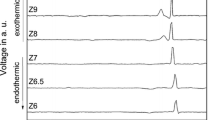The hardness and fracture toughness of ZrO2 – 5.5 wt.% Y2O3 ceramics with a grain size of 0.2, 0.5, 0.9, and 1.55 μm are determined by indentation methods. The deformation relief in the indentation zone and near a crack propagating from the corner of the indentation mark in the ZrO2–Y2O3 ceramics with differing grain sizes is studied by atomic force microscopy. It is shown that the grain size of the ZrO2(Y2O3) ceramics has a significant effect on its hardness, fracture toughness and deformation relief formed during indentation. It is found out that the larger the grain size the lower would be the hardness of the material and the higher its fracture toughness. It is shown that with an increase in the grain size, the average height of the deformation relief increases from 20 to 140 nm. In the ceramic specimens with a grain size of 0.5 μm or more, zones with a changed phase contrast are formed in the emerging deformation relief upon indentation. No such zones are observed in the ceramic specimens with a grain size of 0.2 μm. The width of the zone with a changed phase contrast, measured near the indentation mark corner in the crack propagation region, increases from 0.6 to 1.7 μm, which correlates with the grain size of the experimental ceramics. On the other hand, a quantitative analysis showed that the proportion of relief with a changed phase contrast increases from 11% in the ceramics with a grain size of 0.5 μm to 27% in the ceramics with a grain size of 1.55 μm, which is due a transformation occurring in the ceramics during indentation.
Similar content being viewed by others
References
Y. Zhang and B. R. Lawn, J. Dent. Res., 97, 140 (2018).
I. Denry, M. Abdelaal, D. V. Dawson, et al., J. Prosthetic Dentistry, 126, No. 2, 238 (2021).
J. Eichler, J. Rodel, U. Eisele, and M. Hoffman, J. Am. Ceram. Soc., 90, 2830 (2007).
B. Stawarczyk, M. Ozcan, L. Hallmann, et al., Clin. Oral Invest., 17, 269 (2013).
T. Martin, Ceramics – Silikáty, 52, No. 3, 165 (2008).
R. H.J. Hannink, P. M. Kelly, and B. C. Muddle, J. Am. Ceram. Soc., 83, 461 (2000).
J. Chevalier, L. Gremillardw, A. V. Virkar, and D. R. Clarke, J. Am. Ceram. Soc., 92, No. 9, 1901 (2009).
M. Trunec and Z. Chlup, Scr. Mater., 61, No. 1, 56 (2009).
G. D. Quinn and R. C. Bradt, J. Am. Ceram. Soc., 90, 673 (2007).
D. Tovar-Vargas, E. Roitero, M. Anglada, et al., J. Eur. Cer. Soc., 41, No. 11, 5602 (2021).
D. Casellas, M. M. Nagl, L. Llanes, and M. Anglada, J. Mater. Proc. Technol., 143–144, 148 (2003).
K. Niihara, R. Morena, and D. P.H. Hasselman, J. Mater. Sci. Lett., 1, 13 (1982).
G. R. Anstis, P. Chantikul, B. R. Lawn, and D. B. Marshal, J. Am. Ceram. Soc., 64, 533 (1981).
H. Tsubakino, Y. Kuroda, and M. Niibe, J. Am. Ceram. Soc., 82, No. 10, 2921 (1999).
X. Y. Chen, X. H. Zheng, H. S. Fang, et al., J. Mater. Sci. Lett., 21, 415 (2002).
S. Deville and J. Chevalier, J. Am. Ceram. Soc., 86, No. 12, 2225 (2003).
S. Deville, J. Chevalier, and L. Gremillard, J. Mater. Sci. Lett., 40, 3821 (2005).
Solver Pro SPM. Instruction Manual. MDT-Nanotechnology, Moscow (2006).
G. Shlyakhova and A. V. Bochkareva, Russ. Phys. J., 63, No. 7, 1226 (2020).
N. L. Savchenko, T.Yu. Sablina, I. N. Sevost’yanova, et al., Tech. Phys. Lett., 44, NO. 8, 663 (2018).
Author information
Authors and Affiliations
Corresponding author
Additional information
Translated from Izvestiya Vysshikh Uchebnykh Zavedenii, Fizika, No. 4, pp. 46–52, April, 2022.
Rights and permissions
Springer Nature or its licensor (e.g. a society or other partner) holds exclusive rights to this article under a publishing agreement with the author(s) or other rightsholder(s); author self-archiving of the accepted manuscript version of this article is solely governed by the terms of such publishing agreement and applicable law.
About this article
Cite this article
Sablina, T.Y., Sevostyanova, I.N. & Shlyakhova, G.V. Influence of the Grain Size of ZrO2(Y2O3) Ceramics on the Hardness, Fracture Toughness and Formation of a Transformation-Deformation Relief in the Indentation Zone. Russ Phys J 65, 635–642 (2022). https://doi.org/10.1007/s11182-022-02679-1
Received:
Published:
Issue Date:
DOI: https://doi.org/10.1007/s11182-022-02679-1




